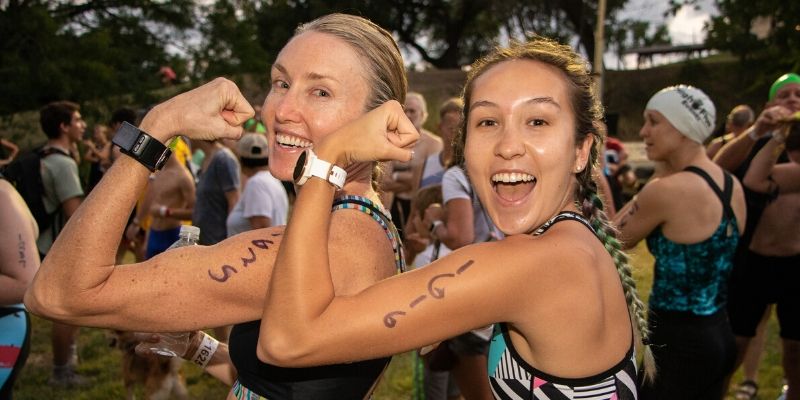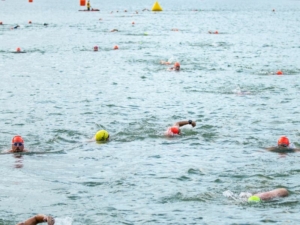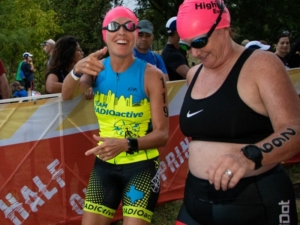Try these dryland swim training exercises to help build strength and improve your performance in the water
Training for the swim portion of your upcoming tri is always important. Although this workout won’t be identical to the benefits you get while actually in the water, such as perfecting your form and practicing your breathing; focusing on these muscles is valuable to enhancing your performance during your tri. Think of these exercises as a way of targeting the same muscle groups you would activate while swimming to keep making forward progress when you’re unable to hit the pool. These dryland swim exercises focus on working your core muscles, quads, glutes, chest, arms, back, and shoulders much like you would in the water.
Burpees
A burpee essentially works all the muscles you would activate during a pool session, but is especially beneficial to help build your stamina. Full body and functional exercise that works on your muscle endurance as well as aerobic capacity.
- Start standing with your feet shoulder-width apart.
- Lower yourself into a squatting position and place your hands on the floor in front of you.
- Jump your feet back, putting yourself into a pushup position.
- Do a pushup.
- Jump your feet back into their original position.
- Stand yourself upright, jump into the air, and clap your hands over your head.
Repeat this exercise in 3 sets of 15.
Lat Pulldown
For this upper body exercise, you need some weight. However, stay light and stretch your shoulders well to reduce the risk of injury.
To do this type of Lat pulldown:
- Sit down at a pulldown machine and place your hands wide apart on the bar, palms facing forward.
- Bring the bar down straight down to your clavicle.
- Keep your torso still as you pull your arms down.
- Draw your shoulders back, pulling the bar down as you exhale.
- When the bar touches your clavicle and your shoulder blades are completely contracted, count to 2.
- Slowly bring your arms back up to starting position, as you inhale.
Control is key during this exercise. Trying to go fast will not work your muscles efficiently and can injure you. If you keep the weight low, you can do 3 sets of 25 for this exercise. don’t rush the exercise don’t go too fast or too slow
Pull-ups
If you do not have access to a pull-down machine, pull-ups will also work your back, muscle, and arms, providing great swimming dryland workout. You can even use the monkey bars at a local playground for this one.
How to do a proper pull-up:
- Move your arms shoulder-width apart and grasp an overhead bar with a firm, overhand grip.
- Hang so your arms and legs are straight.
- Steady your core.
- Keep your back straight and do not swing yourself.
- Pull yourself up, so that your head is over the bar, leaving the bar at your chest.
- Slowly lower your body back to hanging position.
You should also do this same exercise with your hands gripped close together at different distances, to work different muscles. Shoot for about 5 sets of as many proper pull-ups as your strength will allow during each set.
Reaching Lunges
This exercise works your quads and glutes. It will help you with changing direction and help you prevent injuries.
To do a reaching lunge:
- Stand with your feet shoulder-width apart.
- Step far forward with your right leg and shift your weight so that your heel hits the floor.
- Descend until your right shin is vertical and your right thigh is parallel to the floor.
- Lightly tap your left knee to the floor.
- Put your weight back onto your right heel to bring yourself back upright.
- Repeat with your left leg.
When doing these exercises, keep yourself balanced and make sure your knee is bent at a 90º angle does not stick out further than your toe. On each side, also do 3 sets of 15 for this exercise.
T Rotational Pushups
This spin on the traditional pushup offers you a more intense workout. It provides a better core workout, while still hitting the upper body and hip extensors.
To do a T rotational pushup:
- Begin with a rigid torso, in a standing pushup position with your arms and feet shoulder-width apart.
- Descend, bringing yourself chest to the floor.
- Start ascending until your arms are straight.
- Shift over into a side plank position keeping your arms straight.
- Rotate back to push up positions.
- Repeat on the other side
Do 10 reps total, alternating each side, for 3 sets.
Incorporate these dryland swim workouts into your Kerrville Tri training plan so you can be a stronger, more confident swimmer when you hit the water at your next tri.

Showing off those muscles, and getting pumped up for the swim!



